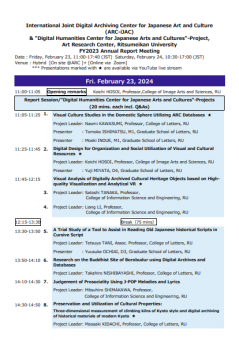-
 With the establishment of the International Joint Digital Archiving Center for Japanese Art and Culture (ARC-iJAC) in 2019, the Art Research Center strives to push the internationalization of research activities that transcend disciplines and geographic boundaries.
With the establishment of the International Joint Digital Archiving Center for Japanese Art and Culture (ARC-iJAC) in 2019, the Art Research Center strives to push the internationalization of research activities that transcend disciplines and geographic boundaries.NEWS


April 10, 2024: The cherry blossoms in front of the Art Research Center (ARC) at Kinugasa Campus, Ritsumeikan University, have reached their peak. 
 The Digital Archiving Workshop comes after the renewal of the MoU between Ritsumeikan University, Ritsumeikan Asia Pacific University, and SOAS University of London, which includes expanding research cooperation in Digital Humanities (DH).
The Digital Archiving Workshop comes after the renewal of the MoU between Ritsumeikan University, Ritsumeikan Asia Pacific University, and SOAS University of London, which includes expanding research cooperation in Digital Humanities (DH).
The workshop comprised of a talk by Prof. Ryo Akama (Director of the ARC) on the ARC Research Space as a comprehensive digital resesarch space for Japanese arts and culture, and a case study by Dr. Ellis Tinios (Honorary Lecturer, University of Leeds) on transforming research in old Japanese books through the ARC Research Space, followed by a practical session on digitization methods for Japanese materials based on ukiyo-e prints and old Japanese books in the SOAS Library collection. >> Read more.

 During the course of the ARC-iJAC project of Dr. Pilar Cabañas and her team of the Asia Research Group (GIA) at the Complutense University of Madrid in the past two years, significant progress has been made in the analysis and cataloging of ukiyo-e albums and illustrated books in the Complutense University Library collection.
During the course of the ARC-iJAC project of Dr. Pilar Cabañas and her team of the Asia Research Group (GIA) at the Complutense University of Madrid in the past two years, significant progress has been made in the analysis and cataloging of ukiyo-e albums and illustrated books in the Complutense University Library collection.
>> Read interview.
 The workshop, co-organized by the ARC-iJAC and the Research Center for Chinese Cultural Metaverse in Taiwan (CCMTW), National Chengchi University, in cooperation with the Department of History, Hong Kong Baptist University, was attended by Prof. Shi-Chi Mike Lan (Deputy Director of the CCMTW), Prof. Chi Man Kwong (Hong Kong Baptist University), and Prof. Keiji Yano (Deputy Director of the ARC), amongst others.
The workshop, co-organized by the ARC-iJAC and the Research Center for Chinese Cultural Metaverse in Taiwan (CCMTW), National Chengchi University, in cooperation with the Department of History, Hong Kong Baptist University, was attended by Prof. Shi-Chi Mike Lan (Deputy Director of the CCMTW), Prof. Chi Man Kwong (Hong Kong Baptist University), and Prof. Keiji Yano (Deputy Director of the ARC), amongst others.
Besides discussing the future collaboration between the ARC and the CCMTW, the workshop provided a valuable opportunity for an exchange opinions on various topics regarding the use of the metaverse in DH research, including platforms suited for research use, methods for acquiring high-quality 3D data, and the application of digital technologies, such as Geographic Information System (GIS), to the metaverse. >> Read more.The 13th Forum for Knowledge, Arts, and Culture in Digital Humanities was held by the Forum for Knowledge, Arts, and Culture in Digital Humanities, co-organized by the Kansai Division of the Japan Art Documentation Society and the Kansai Division of the Japan Society of Information and Knowledge in cooperation with the ARC-iJAC. This event also served as a conference for young researchers of the ARC-iJAC. >> Read more.Video on demand! 130. International ARC SeminarCo-hosted by the Art Research Center (ARC); SOAS Centre for Translation Studies; the Japan Research Centre (JRC), SOAS University of London; and Ritsumeikan Center for Game Studies (RCGS).1. Speaker: Dr. Ali ALAVI (Lecturer in Middle Eastern and Iranian Studies, School of Languages, Cultures and Linguistics & Co-Director of Centre for Iranian Studies, SOAS University of London)
Topic: Beyond Orientalism: The Evolution of Game Studies in Iran's Digital Realm
2. Speaker: Juhyung SHIN (Senior Researcher, Kinugasa Research Organization, Ritsumeikan University)
Topic: Exploring Serious Games in South Korea Upcoming Events
Upcoming Events
May 8 (Wed), 2024
132. International ARC SeminarCo-hosted by the Art Research Center (ARC); the Japan Research Centre (JRC), SOAS University of London; and SOAS Centre for Translation Studies.
1. Speaker: Dr. Monika HINKEL (Lecturer in the Arts of Japan, Department of History of Art and Archaeology, SOAS University of London)
Topic: Contemporary Interpretations of Ukiyo-e
2. Speaker: Prof. Yumi TAKENAKA (Graduate School of Core Ethics and Frontier Sciences, Ritsumeikan University)
Topic:「浮世としての家庭空間─勝川春章《婦女風俗十二ヶ月図》の構図をめぐる試論」
(Domestic Space as an Ukiyo: An Essay on the Composition of Katsukawa Shunshō's "Scenes of Women's Lives in the Twelve Months")
Participation: online via Zoom, free of charge
(relevant parties only, no reservation required)
*This is a closed event and YouTube livestream is not available.


Previous issues:
Winter 2023, Autumn 2023, Summer 2023, Spring 2023, Winter 2022, Autumn 2022, Summer 2022, Spring 2022, Winter 2021, Autumn 2021, Summer 2021, Spring 2021, Winter 2020, Autumn 2020, Summer 2020, Spring 2020[イベント情報]April 17, 2024(Wed)Background:
The ARC-iJAC project Ukiyo-e, illustrated books, albums and painted books in Madrid Collections emerged as an initiative of Asia Research Group (GIA), attached to the Complutense University of Madrid in Spain, which has been collaborating with the Art Research Center (ARC) for about two years and thanks to which significant progress has been made in the analysis and cataloging of ukiyo-e albums and books that are part of the collections of the Complutense University Library and that have remained almost unknown and, in some cases, in a poor state of preservation.
Involved in this project have been the professors Pilar Cabañas, Matilde Arias, Aitana Merino, and Ana Trujillo with the new incorporation of the researcher Alba Finol.
Click here for the Japanese collection of the UCM:
→ARC Ukiyo-e Portal Database
→ARC Early Japanese Books Portal DatabaseCould you please tell us about your motivation and the purpose of conducting the ARC-iJAC research project on the ukiyo-e, illustrated books, and albums in Madrid collections?
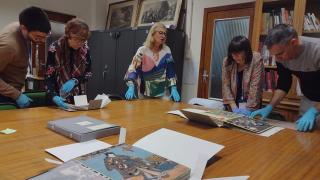
Cabañas: What encouraged us to initiate this project was to give value to the collections of the Complutense Library. Due to a lack of resources, these books and ukiyo-e had remained uncatalogued in the university's collections.
This project has enabled us to study them in-depth and make them known, not only in the Spanish context as part of the heritage of our institution, but also internationally, since the ARC database is a platform of great diffusion for specialists in Japanese art from all over the world. We are delighted with this possibility. Moreover, thanks to this collaboration, being in a space of great specialists, we can compare our knowledge and expand it.
Read more>>[イベント情報]April 9, 2024(Tue)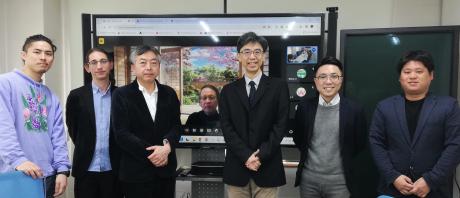
The International Joint Workshop 'Practices and Challenges of Integrating GIS, VR, Metaverse in Digital Humanities Research,' co-organized by the International Joint Digital Archiving Center for Japanese Art and Culture (ARC-iJAC) and the Research Center for Chinese Cultural Metaverse in Taiwan (CCMTW), National Chengchi University, in cooperation with the Department of History, Hong Kong Baptist University, was held on March 25, 2024.
Conducted in a hybrid format--on-site at the Art Research Center (ARC) and online, the workshop was attended by Prof. Shi-Chi Mike Lan (Deputy Director of the CCMTW, National Chengchi University), and Prof. Chi Man Kwong (Department of History, Hong Kong Baptist University) at the ARC together with Prof. Keiji Yano (Deputy Director of the ARC/College of Letters, Ritsumeikan University), amongst others.
The workshop comprised three presentations by the CCMTW and six presentations, including three case studies, by the ARC. Following the presentations, an exchange of opinions took place on various topics regarding the use of the metaverse in Digital Humanities (DH) research, including platforms suited for research use, methods for acquiring high-quality 3D data, and the application of digital technologies, such as Geographic Information System (GIS), to the metaverse.
The workshop provided a valuable opportunity to discuss the future collaboration between the ARC and the CCMTW.
Date and Time: March 25 (Mon), 2024, 10:00-16:50 (JST) / 9:00-15:50 (TST)
Please click →here for program.
Program
Read more>>10:00 Opening Remarks (Prof. Chih-Ming CHEN and Prof. Ryo AKAMA) CCMTW Session 10:10 - 10:55 Taiwanese civilians in Hong Kong after World War II - An example of metaverse digital curation using Gather Town and Omeka S. (Ms. Wei Yuan FAN) 10:55 - 11:40 Preservation of Changhua Roundhouse in Taiwan - An example of metaverse digital curation using Curation Cosmos and Omeka S. (Dr. Ming-Chaun LI) 11:40 - 12:25 Reapproaching Hong Kong's Experience during WWII from the Spatial History Perspective (Prof. Chi Man KWONG) 12:25 - 14:00 Lunch Break ARC Session 14:00 - 14:30 Virtual Kyoto: from GIS, VR and AR to Metaverse. (Prof. Keiji YANO) 14:30 - 15:00 Audience Participation VR, Aesthetic Assessment in Minecraft, and Roblox content for English Education. (Prof. Ruck THAWONMAS) 15:00 - 15:10 Break 15:10 - 15:40 Metaverse as an Archiving Environment for Cultural Resources (Prof. Koichi HOSOI and Mr. Yuzu MINASE) 15:40 - 16:10 ARC Showcase:
→ Three-Dimensional Archiving of Local Historical Embankments Named "Saruo" for Educational Purposes within a Metaverse Platform (Prof. Hiroyuki YAMAUCHI)
→ Construction of an Open WebGIS for Archaeological Sites in Kyoto and Its Potential (Mr. Mikiharu TAKEUCHI)
→ Consensus-Building Tool Utilizing Urban Three-Dimensional Models (Mr. Moeki INOUE)
16:10 - 16:40 Discussion Session: Our future collaboration 16:40 - 16:50 Closing Remarks (Prof. Shi-Chi Mike LAN and Prof. Keiji YANO) [イベント情報]April 8, 2024(Mon)The 13th Forum for Knowledge, Arts, and Culture in Digital Humanities was held on Saturday, March 23, 2024 by the Forum for Knowledge, Arts, and Culture in Digital Humanities, co-organized by the Kansai Division of the Japan Art Documentation Society and the Kansai Division of the Japan Society of Information and Knowledge in cooperation with the International Joint Digital Archiving Center for Japanese Art and Culture (ARC-iJAC), Art Research Center, Ritsumeikan University.
This event also served as a conference for young researchers of the ARC-iJAC.
About the Forum for Knowledge, Arts, and Culture in Digital Humanities:
Along with the rapid development of the digital and information environment in recent years, we are seeing more and more cross-disciplinary research in academic fields with an awareness of "information" and "digital". This trend is gaining momentum in higher education and research activities as well, and educational programs and course activities related to this trend are being enhanced.
The need for opportunities for academic exchange among undergraduate and graduate students and young researchers studying in such programs under new research themes in line with the times is ever increasing.
For this reason, the Forum for Knowledge, Arts, and Culture in Digital Humanities was established in 2011 as a place for presentation and exchange, with a focus on graduate students and young researchers interested in information and knowledge research in arts, culture, and other related fields in mind.
This meeting is positioned as a place where participants can mutually discover new research themes and methods through human exchange in different fields, and we also welcome exploratory and adventurous presentations that are slightly different from conventional conference presentations.
■ Date: March 23 (Sat), 2024, from 13:00 JST
■ Hybrid format:
Venue: Ritsumeikan University Osaka Umeda Campus
Osaka Fukoku Seimei Building, 2-4 Komatsubarachō, Kita Ward, Osaka, 530-0018 (https://www.ritsumei.ac.jp/osakaumedacampus/access/)
Online: Via ZOOMOrganizer: The Forum for Knowledge, Arts, and Culture in Digital Humanities
Facilitators: Ryo Akama (Ritsumeikan University), Mamiko Sakata (Doshisha University), Naoki Takubo (Kindai University), Takehiko Murakawa (Wakayama University)
Co-organizers: The Kansai Division of the Art Documentation Society and the Kansai Division of the Japan Society of Information and Knowledge
In cooperation with: International Joint Digital Archiving Center for Japanese Art and Culture (ARC-iJAC), Art Research Center, Ritsumeikan University.
Read more>>[イベント情報]March 25, 2024(Mon)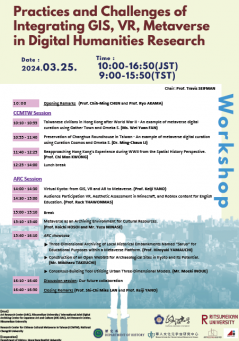
On March 25, 2024, the International Joint Digital Archiving Center for Japanese Art and Culture (ARC-iJAC), Art Research Center, Ritsumeikan University, and the Research Center for Chinese Cultural Metaverse in Taiwan (CCMTW), National Chengchi University will be holding the International Joint Workshop Practices and Challenges of Integrating GIS, VR, Metaversein Digital Humanities Research.
This workshop will be held in English in a hybrid format.
Date and Time: March 25 (Mon), 2024, 10:00-16:50 (JST) / 9:00-15:50 (TST)
Please click →here for program.
Program
Read more>>10:00 Opening Remarks (Prof. Chih-Ming CHEN and Prof. Ryo AKAMA) CCMTW Session 10:10 - 10:55 Taiwanese civilians in Hong Kong after World War II - An example of metaverse digital curation using Gather Town and Omeka S. (Ms. Wei Yuan FAN) 10:55 - 11:40 Preservation of Changhua Roundhouse in Taiwan - An example of metaverse digital curation using Curation Cosmos and Omeka S. (Dr. Ming-Chaun LI) 11:40 - 12:25 Reapproaching Hong Kong's Experience during WWII from the Spatial History Perspective (Prof. Chi Man KWONG) 12:25 - 14:00 Lunch Break ARC Session 14:00 - 14:30 Virtual Kyoto: from GIS, VR and AR to Metaverse. (Prof. Keiji YANO) 14:30 - 15:00 Audience Participation VR, Aesthetic Assessment in Minecraft, and Roblox content for English Education. (Prof. Ruck THAWONMAS) 15:00 - 15:10 Break 15:10 - 15:40 Metaverse as an Archiving Environment for Cultural Resources (Prof. Koichi HOSOI and Mr. Yuzu MINASE) 15:40 - 16:10 ARC Showcase:
→ Three-Dimensional Archiving of Local Historical Embankments Named "Saruo" for Educational Purposes within a Metaverse Platform (Prof. Hiroyuki YAMAUCHI)
→ Construction of an Open WebGIS for Archaeological Sites in Kyoto and Its Potential (Mr. Mikiharu TAKEUCHI)
→ Consensus-Building Tool Utilizing Urban Three-Dimensional Models (Mr. Moeki INOUE)
16:10 - 16:40 Discussion Session: Our future collaboration 16:40 - 16:50 Closing Remarks (Prof. Shi-Chi Mike LAN and Prof. Keiji YANO) The 13th Forum for Knowledge, Arts, and Culture in Digital Humanities will be held online on Saturday, March 23, 2024.
We are now accepting →registrations to join the event as a participant. This event also serves as a conference for young researchers of the ARC-iJAC.
About the Forum for Knowledge, Arts, and Culture in Digital Humanities:
Along with the rapid development of the digital and information environment in recent years, we are seeing more and more cross-disciplinary research in academic fields with an awareness of "information" and "digital". This trend is gaining momentum in higher education and research activities as well, and educational programs and course activities related to this trend are being enhanced.
The need for opportunities for academic exchange among undergraduate and graduate students and young researchers studying in such programs under new research themes in line with the times is ever increasing.
For this reason, the Forum for Knowledge, Arts, and Culture in Digital Humanities was established in 2011 as a place for presentation and exchange, with a focus on graduate students and young researchers interested in information and knowledge research in arts, culture, and other related fields in mind. 11 research meetings have been held to date.
This meeting is positioned as a place where participants can mutually discover new research themes and methods through human exchange in different fields, and we also welcome exploratory and adventurous presentations that are slightly different from conventional conference presentations.
■ Date: March 23 (Sat), 2024, from 13:00 JST
■ Hybrid format:
Venue: Ritsumeikan University Osaka Umeda Campus
Osaka Fukoku Seimei Building, 2-4 Komatsubarachō, Kita Ward, Osaka, 530-0018 (https://www.ritsumei.ac.jp/osakaumedacampus/access/)
Online: Via ZOOMOrganizer: The Forum for Knowledge, Arts, and Culture in Digital Humanities
Facilitators: Ryo Akama (Ritsumeikan University), Mamiko Sakata (Doshisha University), Naoki Takubo (Kindai University), Takehiko Murakawa (Wakayama University)
Co-organizers: The Kansai Division of the Art Documentation Society and the Kansai Division of the Japan Society of Information and Knowledge
In cooperation with: International Joint Digital Archiving Center for Japanese Art and Culture (ARC-iJAC), Art Research Center, Ritsumeikan University.
■ Registration method:
Please register via the <registration form for participants>. (Deadline: Wednesday, March 20, 2024)
※ There is no participation fee.※A get-together is planned to be held after the research presentations (face-to-face only). We would like to make it a place for exchange beyond the boundaries of universities and research fields, so please feel free to join us. The venue, participation fee, etc. will be announced shortly.
Read more>>[イベント情報]March 11, 2024(Mon)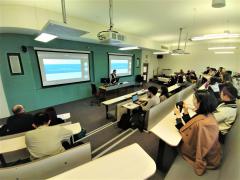
On February 20, 2024, a Digital Archiving Workshop was held by the International Joint Digital Archiving Center for Japanese Art and Culture (ARC-iJAC), Art Research Center, Ritsumeikan University, and the College of Humanities, SOAS University of London, as part of the visit of Prof. Ryo Akama, Director of the ARC, to London.
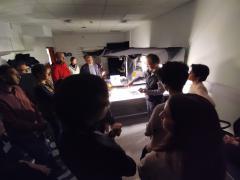
The workshop comes after the renewal of the Memorandum of Understanding (MoU) between Ritsumeikan University (RU), Ritsumeikan Asia Pacific University (APU), and SOAS University of London in December 2023, which includes expanding the cooperation in joint research into the area of Digital Humanities (DH).
The Digital Archiving Workshop, attended by faculty members, library staff, and students of SOAS University of London, began with a general introduction to the ARC and its international research activities in Digital Humanities, followed by a case study examined by Dr. Ellis Tinios (Honorary Lecturer, University of Leeds & ARC Collaborative Researcher) on 'Transforming Research in Early Japanese Books through the ARC Research Space,' and a lecture by Prof. Akama on 'The ARC Research Space--Aiming at Perfecting a Comprehensive Digital Research Space for Japanese Arts & Culture.'
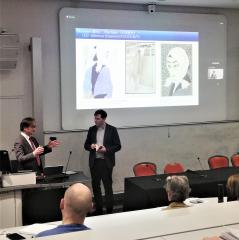 The workshop then moved on to a section focusing on practical techniques. Prof. Akama demonstrated and explained digitization methods for Japanese materials based on the woodblock prints and old Japanese books in the collection of the SOAS Library. Audience members were given the opportunity to obtain hands-on experience in digitizing these materials.
The workshop then moved on to a section focusing on practical techniques. Prof. Akama demonstrated and explained digitization methods for Japanese materials based on the woodblock prints and old Japanese books in the collection of the SOAS Library. Audience members were given the opportunity to obtain hands-on experience in digitizing these materials.On February 21, 2024, Prof. Akama gave a public lecture organized by the SOAS Japan Research Centre (JRC) entitled 'The End of Actor Prints (役者絵): How did the Meiji Era's Actor Prints Disappear?'
[イベント情報]February 26, 2024(Mon)The 13th Forum for Knowledge, Arts, and Culture in Digital Humanities will be held online on Saturday, March 23, 2024.
We are now accepting →registrations to join the event as a participant. This event also serves as a conference for young researchers of the ARC-iJAC.
About the Forum for Knowledge, Arts, and Culture in Digital Humanities:
Along with the rapid development of the digital and information environment in recent years, we are seeing more and more cross-disciplinary research in academic fields with an awareness of "information" and "digital". This trend is gaining momentum in higher education and research activities as well, and educational programs and course activities related to this trend are being enhanced.
The need for opportunities for academic exchange among undergraduate and graduate students and young researchers studying in such programs under new research themes in line with the times is ever increasing.
For this reason, the Forum for Knowledge, Arts, and Culture in Digital Humanities was established in 2011 as a place for presentation and exchange, with a focus on graduate students and young researchers interested in information and knowledge research in arts, culture, and other related fields in mind. 11 research meetings have been held to date.
This meeting is positioned as a place where participants can mutually discover new research themes and methods through human exchange in different fields, and we also welcome exploratory and adventurous presentations that are slightly different from conventional conference presentations.
■ Date: March 23 (Sat), 2024, from 13:00 JST
■ Hybrid format:
Venue: Ritsumeikan University Osaka Umeda Campus
Osaka Fukoku Seimei Building, 2-4 Komatsubarachō, Kita Ward, Osaka, 530-0018 (https://www.ritsumei.ac.jp/osakaumedacampus/access/)
Online: Via ZOOMOrganizer: The Forum for Knowledge, Arts, and Culture in Digital Humanities
Facilitators: Ryo Akama (Ritsumeikan University), Mamiko Sakata (Doshisha University), Naoki Takubo (Kindai University), Takehiko Murakawa (Wakayama University)
Co-organizers: The Kansai Division of the Art Documentation Society and the Kansai Division of the Japan Society of Information and Knowledge
In cooperation with: International Joint Digital Archiving Center for Japanese Art and Culture (ARC-iJAC), Art Research Center, Ritsumeikan University.
■ Registration method:
Please register via the <registration form for participants>. (Deadline: Wednesday, March 20, 2024)
※ There is no participation fee.※A get-together is planned to be held after the research presentations (face-to-face only). We would like to make it a place for exchange beyond the boundaries of universities and research fields, so please feel free to join us. The venue, participation fee, etc. will be announced shortly.
Read more>>[イベント情報]February 24, 2024(Sat)Day 1: Friday, February 23, 11:00 -17:40 JST (tentative)
Day 2: Saturday, February 24, 10:30:00 -17:00 JST (tentative)Hybrid event (ARC & online via Zoom)
Presentations marked with ★ are available via YouTube live stream.
Organised by: International Joint Digital Archiving Center for Japanese Art and Culture (ARC-iJAC) & Digital Humanities Center for Japanese Arts and Cultures "Program for Supporting Research Center Formation", Ritsumeikan University
Click here for the program.
[イベント情報]February 23, 2024(Fri)Day 1: Friday, February 23, 11:00 -17:40 JST (tentative)
Day 2: Saturday, February 24, 10:30:00 -17:00 JST (tentative)Hybrid event (ARC & online via Zoom)
Presentations marked with ★ are available via YouTube live stream.
Organised by: International Joint Digital Archiving Center for Japanese Art and Culture (ARC-iJAC) & Digital Humanities Center for Japanese Arts and Cultures "Program for Supporting Research Center Formation", Ritsumeikan University
Click here for the program.



